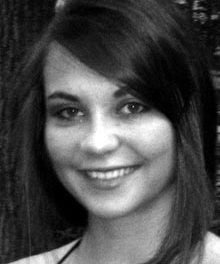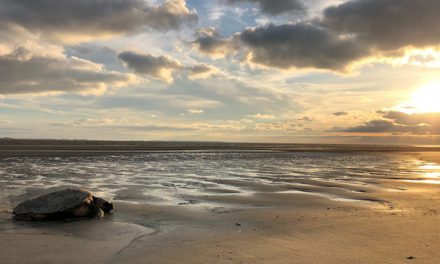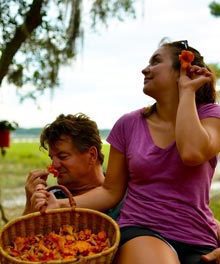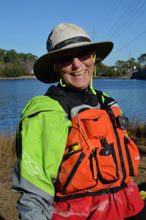 By Tess Malijenovsky
By Tess Malijenovsky
Emerald Isle – By the time she made it to my apartment, Deborah Walters, a 63-year-old grandmother, was halfway through a 2,500-mile journey from Maine to Guatemala. She’s traveling in a kayak. Alone.
“A lot of people go out paddling for a day and then pull a short night and sleep,” says Walters. “Well that’s all I’m doing. The only difference is that I’m doing it day after day after day until I get to Guatemala.”Walters isn’t kayaking simply for the sake of going farther than she’s ever gone before – and perhaps farther than any woman her age has gone before solo. She wants to raise $150,000 for children living in Guatemala City’s garbage dump by stopping along the way to tell their story.
“In large parts of the world people come up with a hand out, but I don’t get inspired then,” Walter says. “In Guatemala, it’s the people (who are) working really hard to help themselves and, with just a little bit of help from outside, I see how it can make a big difference.”
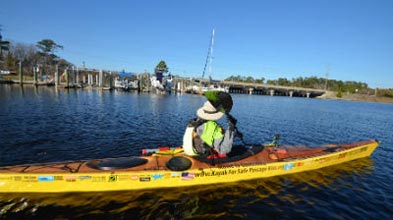
She was once the board president of a nonprofit in Guatemala City called Safe Passage, which educates and feeds over 500 children – the poorest of the poor, she tells me. The group doesn’t have the capacity yet to help all 2,000 children living in the garbage dump.
For the last two years, Walters has been actively planning this trip. And on July 13, a day after she left Yarmouth, Maine, she kissed her husband, Chris, goodbye on their wedding anniversary for her grand sendoff from Portland.
Five months later, she’s breaking bread at my small kitchen table, politely refraining from wolfing her food to satiate her constant hunger.
Walters is wearing the same outfit she’s worn the last two days: grey cargo pants and a black sweater. She’s only brought a few articles of clothing with her on the trip, the others reserved for either paddling or public speaking. She also wears a Velcro strap around her right forearm for support; it helps with the pain and numbness she’s been experiencing in that arm as she paddles.
Despite having a little arthritis, this is a woman who has kayaked hundreds of miles among the minke whales and narwhals in the Canadian Arctic on six separate occasions. She’s finished first place in kayak races – and last too, the only “solo old broad” in her division, as her friends like to joke. Including, a 300-mile race across the Florida panhandle and through the Everglades.
She loves the feeling of being completely self-sufficient in her kayak and to travel by “human-power,” she says. By hiking or kayaking, “you see more of the world and you’re more connected.”
As opposed to being transported by a plane, when you’re kayaking along the East Coast, Walters says, “you can see the changes in the environment and the changes in the people and in the culture and in the food as you go along — you feel like you’re really there.”
Paddling from Maine to Guatemala, however, will be a physical feat greater than any she’s ever attempted before.
That’s why she’s doing this trip in true granny fashion: safety first. Averaging about 15 miles a day, Walters likes to paddle two days in a row and take the third day off to rest. “I don’t do anything that I think is dangerous,” she says. “If I think there’s a 75 percent chance that I can make it, I would never go out. Conditions can always get worse.”
She’s bypassing the Gulf of Mexico, she says, to avoid getting shot by the Mexican drug cartels. Instead, Walters and her 18-foot kayak are getting a lift, from Key West, Fla., to Belize, on a sailboat where she’ll continue the last 200-mile stretch of her voyage. Or, so she hopes.
Walters, at least, owns up to her slower pace and cautionary style: “Some people when they go on these expeditions it’s like this big macho thing, like ‘me against nature.’ For me, it’s more like ‘me with nature,’ and sort of becoming more a part of the natural flow of things.”
go on these expeditions it’s like this big macho thing, like ‘me against nature.’ For me, it’s more like ‘me with nature,’ and sort of becoming more a part of the natural flow of things.”
When I volunteered to host Walters for three nights, I had no idea how famous she was becoming. I’d only signed up to help a stray traveler as I had with many others before her. Also, I wanted to meet the living proof that at any age one can embark on the expedition of one’s lifetime.
“Getting into the kayak in the morning when it’s cold and I don’t know the waters and I hear there’s terrible currents right ahead of me, it feels like I’m jumping off a cliff,” Walters says after we finished our breakfast. “Quite often, I’m not convinced that I can make it, you know? Why am I doing this? I sort of go through this most days.”
Then she recalls the first time she visited the garbage dump.
“The first time that I went there,” Walters says, “there was a family that came running up to the Safe Passage office to ask if we had a metal detector. The husband, who’d actually done some plumbing for us, had driven his pickup truck into the dump to drop off some things but a sink hole opened up under his truck.
“He didn’t know where you could and couldn’t drive there. He and his truck just disappeared down in this garbage. We found a metal detector really quickly and gave it to them, but they never found him,” Walters says. “So many people have fallen in sink holes there or gotten covered up in a land slide and died.”
The garbage dump serves nine million people. It’s in the middle of Guatemala City, the country’s capital and the largest city in Central America. Medical waste and hazardous chemicals are also disposed there; and the river that runs through it is basically an open sewer, Walters says. Roughly 10,000 people live there scavenging for food, collecting recyclables to sell and sleeping in housing built upon mountains of disintegrated trash.
“Visitors aren’t allowed in the actual part of the garbage dump anymore,” she says, “so we were up on a cliff in an old cemetery looking down. All the people looked like little ants as they were lining up beside the garbage trucks, sorting through the garbage and collecting whatever they could find in there.”
Breathing problems and skin disease are common for the people trying to survive in the dump, Walters says. Even from the cliff where Walters was watching, the air she breathed in reeked of the rotting garbage; and while many visitors applied fragrant oils above their upper lip to help hide the smell, Walters refused. There were great swirls of dust, she says, and many vultures circling above.
Over the last nine years, Walters has listened to the stories of many women and children at Safe Passage. Like Myra, a 70-year-old woman who has been on her own in the dump since she was the age of five. Walters says Myra once told her that she didn’t have any big dreams growing up: “I wasn’t living,” she’d told Walters. “I was only surviving.”
For the mothers, their greatest desire is for their children to go to school for a chance at a better life. The public and private schools used to require uniforms and books, which the mothers couldn’t afford; but even if they could, the schools refused to accept the children, dismissing them as “garbage.”

That attitude has come a long way, Walters says, since Safe Passage opened its doors. The organization has made tremendous progress in the relationship between the schools and the children from dump. And while on average 10 percent of all Guatemalans graduate high school, 40 percent of children in Safe Passage programs will graduate. Though Walters is confident that 100 percent of them would if Safe Passage was a full-time school. If she can raise $150,000, Walters hopes to convert an after-school program into the third and fourth grades.
So she pushes on day by day. Mile by mile. “It’s daunting to think of the whole thing,” Walters says, “but if you think a piece at a time — and when you think that the waterways were the communication highways of the world for such a long time, and maybe become more so in the future – it can be done,” Walters says.
“But, what does it take to do it?” I ask. “To take on what seems like an impossible challenge?”
“It’s what the people in the garbage dump have,” she answers. “Grit, determination, persistence. Because I really believe that ordinary people, like me, can do extraordinary things if you just keep at it, if you just persist.”
IN BEAUFORT
Deborah Walters will be passing through Beaufort on January 24th and 25th. As of this publication, she had no speaking engagements arranged. To learn more about Deborah Walters’ kayaking expedition or to help support the children living in Guatemala City’s garbage dump, visit: www.kayakforsafepassage.org
Tess Malijenovsky is an occasional contributor to Lowcountry Weekly who lives in Emerald Isle, NC. This article first appeared on Coastal Review Online at www.nccoast.org


